| << Chapter < Page | Chapter >> Page > |
We saw earlier that Fourier analysis is not well suited to
describing local changes in "frequency content" because thefrequency components defined by the Fourier transform have
infinite (

The Short-Time Fourier Transform (STFT) provides a means of joint time-frequency analysis. The STFT pair can be written assuming real-valued for which . The STFT can be interpreted as a "sliding window CTFT": to calculate , slide the center of window to time , window the input signal, and compute the CTFT of the result ( [link] ).

The idea is to isolate the signal in the vicinity of time , then perform a CTFT analysis in order to estimate the "local" frequency content attime .
Essentially, the STFT uses the basis elements over the range and . This can be understood as time and frequency shifts of the window function . The STFT basis is often illustrated by a tiling of the time-frequency plane, where each tile represents aparticular basis element ( [link] ):

The height and width of a tile represent the spectral and temporal widths of the basis element, respectively, and theposition of a tile represents the spectral and temporal centers of the basis element. Note that, while the tiling diagram suggests that the STFT uses a discrete set of time/frequency shifts, the STFT basis is really constructed froma continuum of time/frequency shifts.
Note that we can decrease spectral width
at the cost of increased temporal width
by stretching basis waveforms in time, although the
time-bandwidth product
(

Our observations can be summarized as follows:

Notification Switch
Would you like to follow the 'Dspa' conversation and receive update notifications?